The Mews Letter of (Not Quite) Everything
This week: guest correspondent Ed Jefferson is attempting to visit every Mews in Greater London.
Jonn here. I am still, at time of writing, in Lisbon, and – history would suggest – am probably by this point a fetching shade of pink. So as promised, this week’s newsletter is a guest post.
I first met Ed Jefferson on a Usenet group about six months shy of a quarter century ago, which I think makes him my longest standing online friend. He wrote a series of glorious posts for CityMetric back in the day, in which he put the tube lines through the Myers Briggs tests, say, or ranked all 63 ways you can cross the Thames in London. The contents of his brain, such as it is, were always a joy to find in my inbox of a morning.
Recently Ed embarked on a new project: visiting every mews in Greater London, for some reason, and writing about it in his weekly (one suspects the name came first) Mews Letter. You can, and should, subscribe to that here, but to give you a sense of why here’s issue #1. It’s a bit long – your email client may cut off the end, necessitating you to click through to read the rest – but it’s worth it, I promise.
I’m not sure exactly what Rishi Sunak’s time as Prime Minister will be generally remembered for, other than a sort of dim awareness that it happened, but one particularly pathetic moment that will stick with me is the time he went for a run round central London with ‘The Hardest Geezer’ to talk about mental health or something. ‘The Hardest Geezer’, aka Russ Cook, had just spent 352 days running the length of Africa to raise money for charity, an admirable feat, but one which Sunak bizarrely claimed had more impact “than any amount of government policy”, which is a weird thing to say when you’re in charge of all the government policies. If he actually believes this, why is he bothering to lead the Tories into the election when he could be riding from Land’s End To John O’Groats on a unicycle, nude?
Anyway, this got me thinking – was there some slightly involved but ultimately futile thing that I could achieve as a powerful message of hope in the hour of the country’s greatest need? Ideally, one where I wouldn’t have to spend 352 days sleeping in a van in random bits of Africa.
Over the last two and a bit decades I’ve spent a lot of time walking around London, and I’ve always had the idea that there should be a strategy for ‘completing’ the city. Abandoned ideas have included: walking the boundary of every borough, plotting random routes across every postcode area, walking in circles – centred on Charing Cross – that increase in diameter until they leave the city entirely, trying to algorithmically plot routes where all the streets are in alphabetical order, and so on. The big one, of course, would be to have walked every single street in London.
Is that possible? There’s a website called CityStrides.com where walkers and runners upload GPS data about routes they’ve taken – the site then calculates what % of the streets in a given city they’ve covered on foot. The person with the record for London is ‘The Purple Runner’, who has covered over 16 thousand of the 39 thousand listed on the site. This has taken him over 5 years, and a rough calculation of # of roads covered per day suggests it’ll be well into the 2030s before he has covered all of them. I connected it to the app I sometimes use to log walks and I have covered 1.28% of the streets in Greater London, ranking me at #795. Which by my calculations means I will reach 100% some time in the year 2635. Hmm.
Visiting every street in London is harder than it used to be – within the Square Mile – the old City of London, CityStrides lists 468 streets covering 42 miles – 8 people, including The Purple Runner, have recorded running all of them, it seems at least plausible others must have at least come close without recording it – officials documenting need street repair, lunatics trying to ‘collect’ bollards, and who knows who else throughout the centuries. But in 2024 the City is not really the city in a meaningful sense, is it?
You can always fiddle the definition of London in other ways, of course – blogger Noelle Poulson claims to have walked “all the streets of London” in between 2012 and 2016. But not to belittle what is, in itself, an impressive feat, she didn’t actually walk every street in London – she walked every street in the Congestion Zone. Which, I would argue, absolutely no-one else thinks of as ‘London’ – and there’s actually something a bit perverse about defining a walk by a boundary designed for cars, isn’t there? Like some sort of weird car roleplay. Is there a car version of furries where you walk around with an exhaust pipe sticking out of your bum?
The other alternative is just to tell people you’ve walked every street in London without actually bothering to do it. According to legend, and several apparently authoritative sources, Phyllis Pearsall, the original compiler of the London A-Z map, spent months walking 23,000 streets, in 18 hour shifts. This is, unfortunately, almost certainly not true – apart from anything else, by 1936, when she was putting together the A-Z, personally walking all the streets involved would have been a fairly pointless exercise when you could just compile the map from existing plans held by local councils.
Her A-Z also wasn’t the first publication of its type, even if it did become the most famous, and how much credit Pearsall should really be given has been debated, by among others, her own half-brother. He has a website angrily debunking a lot of claims made about Pearsall, specifically bemoaning that their father’s role has been much downplayed, though the tone of it is a bit, er, well – family can be complicated! Still, going down in legend for having done something is almost as good as having actually done it, I suppose. But even then: the original A-Z did not cover every street in what is now Greater London.
So: would take too long to walk every street in Greater London, don’t want to walk every street in some particular bit of Greater London, certainly don’t want to just lie about walking every street in some particular bit of Greater London. But what if there was a more feasibly visitable subset of streets, found throughout the capital? For example, every street called ‘[something] Mews’: is visiting all of those achievable? Well, if it is, I will declare myself the Softest Geezer and demand that I am allowed to yell “MENTAL HEALTH” at Sir Keir Starmer until he starts crying and declares that what I have done is better than any of his stupid policies.
Subscribe to the Mews Letter now!
MEWSES VISITED THIS WEEK
#1 Admiral Mews, Kensington and Chelsea, W10
Took its name from a pub on the nearby corner of Ladbroke Grove, the Admiral Blake, itself named for a man who, having been deemed “too short” to be an academic, became an MP and fought in the Civil War, notably saying he’d eat three of his four pairs of boots before surrendering Taunton to the Royalists. He was then put in charge of key bits of the Navy, introduced such innovations as ‘having tactics’ and ‘reliably winning battles’, and upon his death was buried in Westminster Abbey… for about three years, until the monarchy was restored and Charles II had his corpse booted back out again. Owned.
Inversely, pub gained the nickname ‘The Cowshed’ from what used to stand on the site of the mews, and by the time it featured as the exterior of the pub in the early 2000s Al Murray The Pub Landlord sitcom this had become the actual name. Opinions on the pub varied, from “a really lovely spirit on a Saturday night” to “avoid if possible”, and eventually in 2012 it was demolished to build a residential block that is allegedly called ‘Admiral Blake House’, though I couldn’t find any evidence of this name by say, ‘looking at the building’.
The mews is now a yard belonging to a waste management company. Cows, retvrn.
#2 Lionel Mews, Kensington and Chelsea, W10
Once home to Old Tom Bunn, London’s oldest farrier, who had been shoeing horses for 60 years as of his death in 1930. I bet you don’t know who London’s oldest farrier is now! Or what a farrier is!
The building on the eastern side of the Mews pre-dates the 1960s redevelopment that saw everything else demolished, and was once a canteen for bus drivers. If you’re not sure what a canteen for bus drivers is, helpfully in 1951, the London Transport Executive produced a film to explain, narrated in character by someone pretending to be one of the women who worked there. The film warns us that bus drivers who come in for their dinner are likely to be rude arseholes, but apparently that’s just what you have to put up with to keep London moving, so: big smiles, ladies!
A farrier puts horseshoes on horses. Obviously. Are you London’s oldest one? Write in!
#3 Munro Mews, Kensington and Chelsea, W10
If your job is flogging stuff at Portobello Road Market you ideally need somewhere nearby to store the stuff when it is not being flogged, and once upon a time that might have been the ground floor of the buildings on Munro Mews, originally built as stables. Slum clearance was mooted in the 1950s causing arguments along the lines of:
Council: This is shit and needs to be demolished.
Resident: I live here, are you calling me shit mate?
Eventually the council (half) won, and the properties on the north side were compulsorily purchased, demolished and replaced with lock-ups that continued to be used by stallholders for storage until they were in turn demolished and replaced by housing in the 2010s as part of the redevelopment of the adjacent Wornington Green estate, which itself will presumably be demolished in 40 years time to build some stables.
The day I visited there was a note on a bicycle storage locker announcing that someone called Augusto is away until April, so do bear this in mind.
#4 Golborne Mews, Kensington and Chelsea, W10
Golborne Mews earned two minor notes in rock history by a) featuring on the cover of a solo album by Paul Kossof of the band Free (‘All Right Now’ and some other songs presumably), borderline doxxing himself as it was where he lived b) being where The Pretenders’ guitarist James Honeyman-Scott suffered a fatal drug overdose 1982. Given Kossof had also died of a presumed drug-related heart attack, any other rock guitarists who can afford the million plus quid one of these houses goes for now would be advised to look elsewhere.
#5 Kelfield Mews, Kensington and Chelsea, W10
In the thriller ‘The Underhanded: A Novel’, an academic and an ex-MI6 officer have to fight a neofascist cabal called the Strasbourg Executive! Exciting! Anyway, at one point the characters have to escape the bad guys by running out of the back of a house into an alley near Kelfield Gardens, which may or may not be Kelfield Mews. No obvious evidence of neofascist cabals that I could see, unless the nursery school at the end is a front.
#6 Trinity Mews, Kensington and Chelsea, W10
If you put a big black gate in front of your Mews so people can’t even see in, be assured that I will assume the worst. You monsters.
#7 Scampston Mews, Kensington and Chelsea, W10
Much of this area is part of the St Quintin estate, so named because it was built on land belonged to the St Quintin family, part of the aristocracy until someone forgot to have any children and their title died out. The family pile is/was Scampston Hall in North Yorkshire, so the name is presumably someone sucking up to the boss. There is no number 13 listed on the entrance buzzer thing: cowards.
#8 Charlotte Mews, Kensington and Chelsea, W10
A 1980s shared ownership scheme built on the Silchester Estate. Residents of the more high density housing on the rest of the estate had apparently not been all that enthusiastic about exercising their right to buy – this scheme was devised as an alternative to make it easier for existing residents to buy a home, while freeing up their original properties for new council tenants.
The immediate area had experienced a slightly more radical solution to housing issues – in the 1970s a group of squatters took over deteriorating and abandoned properties in roads just south of the estate. When the Greater London Council announced a plan to demolish them, the residents (including the actor David Rappaport off of Time Bandits) declared independence from the UK, set up the Free & Independent Republic of Frestonia, and applied to join the UN. As a backup plan, citizens of Frestonia all changed their surnames to ‘Bramley’ so that in the event of eviction the council would have to rehouse the ‘family’ as a single group.
Eventually – presumably because of the resulting publicity as much as anything – a compromise was reached: the houses would be demolished, but new homes would be provided for residents as part of the fittingly-named Bramley Housing Co-op.
#9 Camborne Mews, Kensington and Chelsea, W10
Pevsner’s architectural guide notes that this is a “tactful” 1980s addition to the Lancaster West Estate, by which they mean that the post-war high rise modern living ambitions of the original development were abandoned in favour of fairly generic terraced housing. Whether this is a good or bad thing will depend on whether you think the issues these kinds of estates have had were purely down to innate architectural flaws or whether part of the problem was that invariably no-one wanted to spend the money to finish them as planned with actual community infrastructure, shops, etc, let alone budget enough for proper upkeep. I suppose.
#10 Ruston Mews, Kensington and Chelsea, W11
Ruston Mews used to sit just over the road from a street called Ruston Close which may not sound all that notable, but is, in that in 1953 the residents petitioned the council to change their street’s original name, Rillington Place, on account of it having become quite famous when it was discovered that John Christie had spent 10 years murdering (and then secreting the bodies of) several people there. The unmurdered residents reported that they were being treated with ‘eager curiousity, even ridicule’ and that their children were being bullied. At least they didn’t have true crime podcasters back then. Ruston Close was demolished in the 1970s.
If anyone has been doing serial murders in Ruston Mews it has yet to be discovered, but if it turns out they are the council should rename it to Rillington Close, just to make things even more confusing.
Total mewses visited: 10/2381
That was the first edition of The Mews Letter, in which Ed Jefferson attempts to visit every mews in London while writing a weekly compilation of history/facts/jokes about them, the city and other tangential matters. You can read a further eleven issues here, and sign up for future instalments here. I, by which I of course mean Jonn Elledge, will be back here as myself next week.
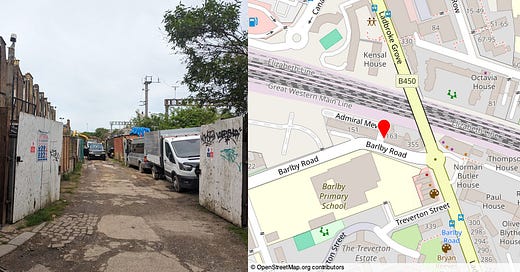



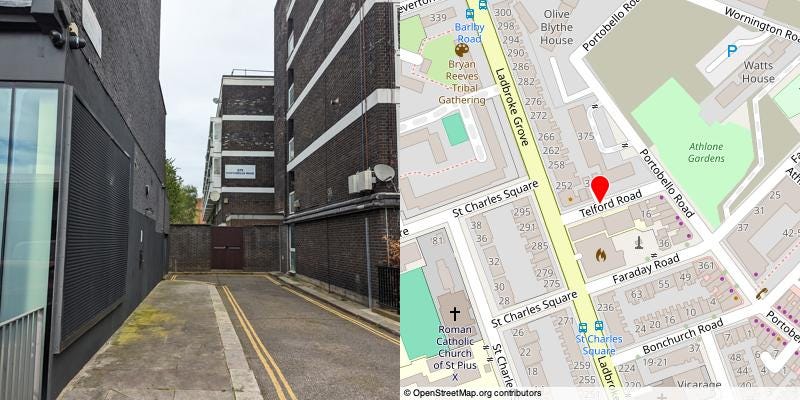

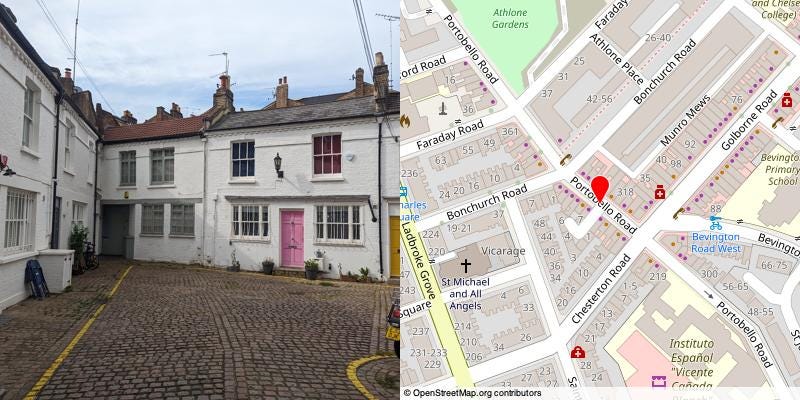
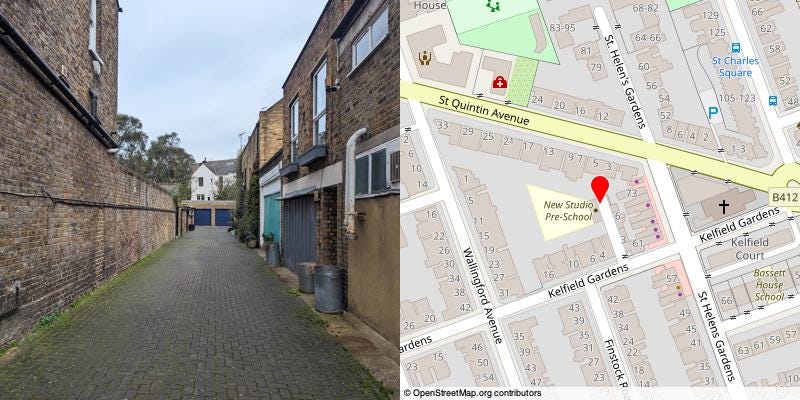
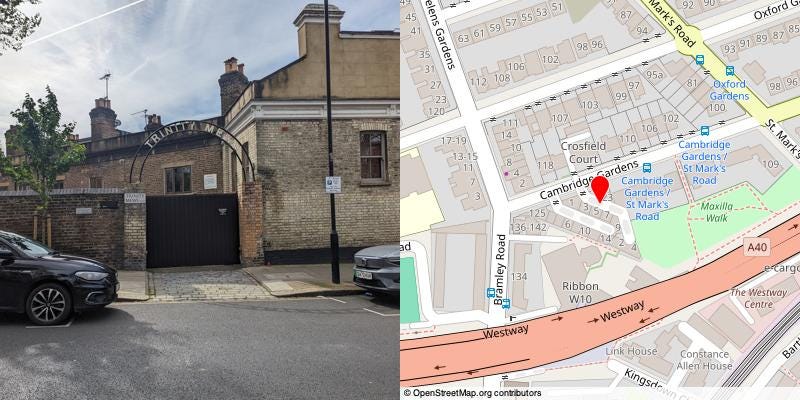



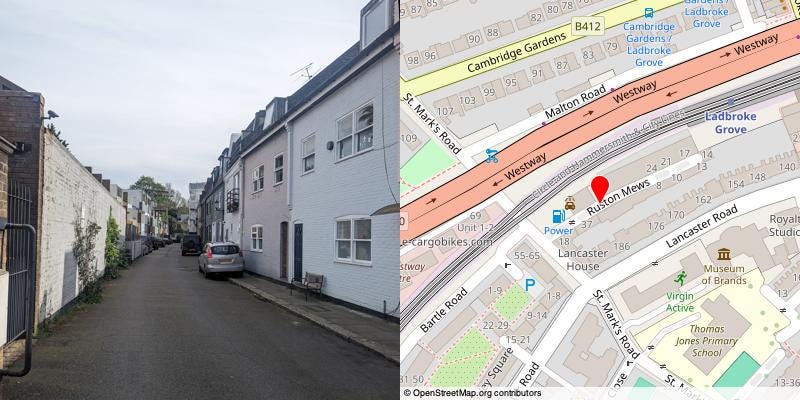
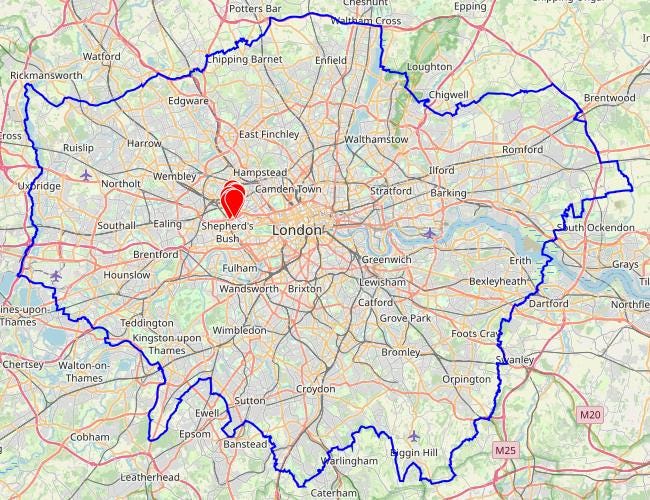
I’m always curious about the history of mews buildings so this is right up my alley
so far, an utter delight. And I'm a zillion miles away from London.